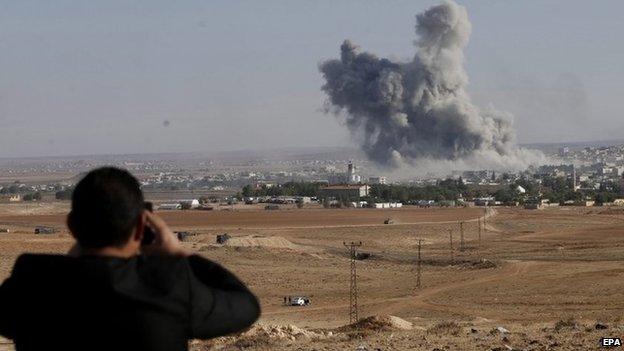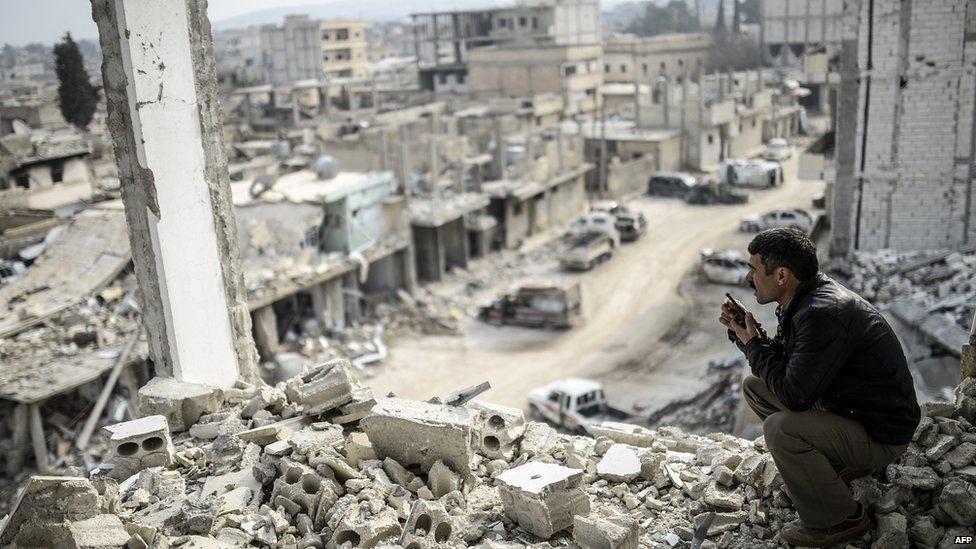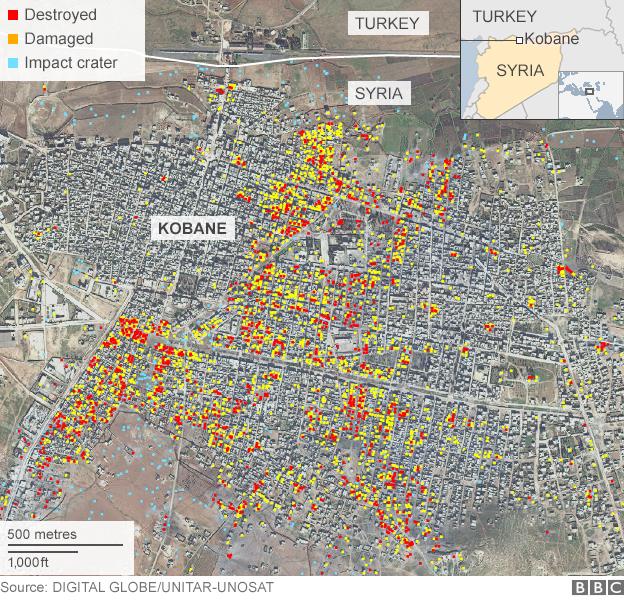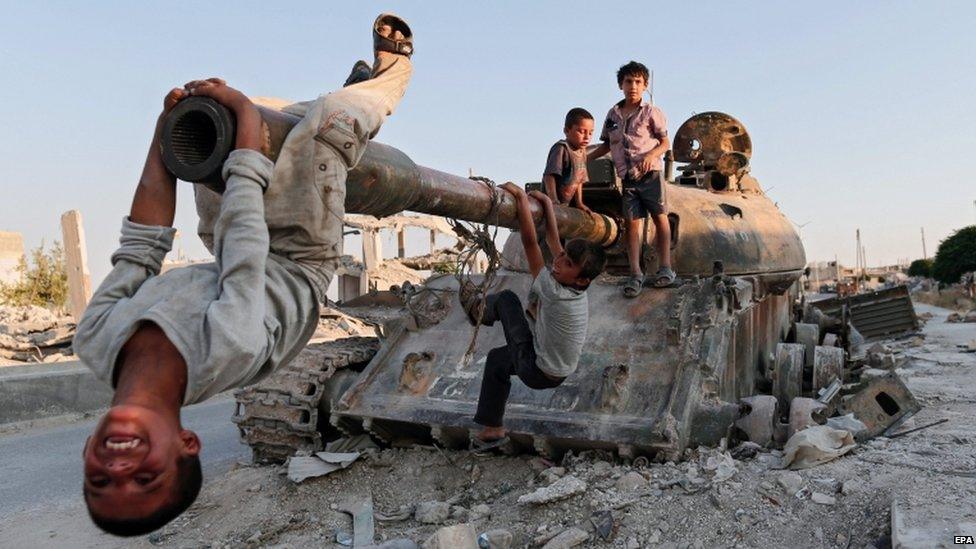Battle for Kobane: Key events
- Published

Looking on: Residents watch from Turkey as the battle ravages their town
Kobane has been a battleground between Islamic State (IS) militants and Kurdish fighters since September 2014, when IS fighters overran the small northern Syrian town, forcing almost all of its civilians to flee into Turkey.
International air strikes led by the US helped to push back IS fighters, allowing Kurdish fighters to eventually regain control of the town at the start of 2015.
But the victory, heralded by some as a symbolic defeat for IS, was not to last, with IS militants launching a fresh attack on 25 June.
Here's a look at how the crisis there has unfolded, featuring stories from BBC reporters on the ground.

18 - 22 September 2014 - Fleeing civilians
In just four days, the UN says over 130,000 people have fled across the border into Turkey as IS forces advance through the countryside and surround Kobane.
As Kurdish fighters battle IS inside Syria, refugees clash with security forces on the Turkish side of the border. All the while, civilians continue to bear the cost, as one mother who had just given birth told the BBC's Mark Lowen.
Mark Lowen reports from Turkey's border with Syria, where refugees are flooding in: ''The sheer numbers would overwhelm any country''

27 September - Coalition air strikes begin
The US-led aerial coalition, which has been conducting strikes against IS targets in Iraq since August, launches its first attacks on the group near Kobane.
US air strikes targeted a Kobane building owned by Islamic State, as Laura Westbrook reports
The strikes come as IS continues to close in on the town, which at this point has become a focus of dogged resistance on a stretch of the Syrian-Turkish border that IS otherwise controls.


6 - 11 October - IS advances, rising death toll
Despite US air strikes and Kurdish resistance, IS fighters break through into Kobane in early October and take districts in the east and south of the town. Their black flag can be seen from inside Turkey, where refugees can only stand and watch.
Islamic State's black flag has been seen above Kobane for the first time, reports Paul Adams
At least 533 people are reported to have died in almost a month of fighting, including 298 IS fighters.

14 - 30 October - Kurdish fighters push back, retake hill
The US-led coalition steps up strikes on militants in the town, and a counter-offensive by Kurdish fighters sees them take back an important hilltop overlooking Kobane which was captured by IS 10 days previously. The Kurds sense momentum but they are exhausted by weeks of fighting, as one fighter tells BBC Arabic's Wael El Hajjar.
One fighter battling IS in Kobane: 'There is no time for sleep'
On 20 October, the US military air drop much-needed weapons, ammunition and medical supplies to anti-IS fighters. Ten days later, the first contingent of Kurdish Peshmerga militia men from Iraq cross from Turkey into Syria to join their Syrian Kurdish allies, the People's Protection Units (YPG), in the fighting.

November - Kobane residents who stayed
The Islamic State siege of Kobane enters its second month, with many of the town's residents now gone. One woman, who stayed in the town having moved there not long before the attack, tells the BBC's Mehrdad Farahmand what life there is like.
Roshan Isso in Kobane: "After a couple of roofs crashed above our head we got used to it"
Meanwhile, a video journalist who managed to get access to the town shoots footage of Kurds on the front line, revealing the full scale of the destruction.
Footage shows Kurdish fighters in Kobane
Aided by air strikes, Kurdish fighters continue to steadily push back the IS advance over the coming weeks.

6 - 19 January 2015 - Major Kurdish advances
Kurdish fighters manage to seize a key district and activists say they now control 80% of the town.
Two weeks later, the Kurds regain control of another strategic hill top, putting key IS re-supply routes within the line of fire. Analysts say the recapture of Mishtenur hill could prove to be a defining moment for the fate of Kobane.

Kurdish fighters in Kobane have been pushing to gain control of the town

26 January - IS driven out
Officials say IS militants have been driven out, ending a four-month battle for the northern Syrian town.
The pivotal moment follows several days of heavy aerial bombardment by coalition aircraft, with 17 air strikes carried out in the 24 hours from the morning of 25 January.
Activists say the fighting left at least 1,600 people dead, among them 1,196 jihadists.

Kobane's regional government says at least 50% of the town has been destroyed.
The BBC's Middle East correspondent Jim Muir warns that while Kobane has been almost entirely recaptured by the Kurds, the fight is by no means over.
Kobane residents in Turkish refugee camps are eager to return to their homes.
The BBC's Nafiseh Kohnavard met refugees in Turkey waiting to return to Kobane

February - Assessing the destruction
Journalists, including the BBC's Quentin Sommerville, enter the town for the first time since fighting began. Their cameras reveal scenes of destruction, with many buildings in ruins and streets full of rubble.
"Every building, home, shop and street is ruined," he says. Refugees in Turkey start returning to their homes.
Quentin Sommerville described an 'apocalypse' in Kobane after IS was driven out in February
An analysis of satellite imagery by the UN shows more than 3,200 buildings were destroyed or damaged during the four months of fighting.


25 June - IS re-enter Kobane
Following a string of defeats to Kurdish forces, IS launch a two-pronged offensive in the north, including a fresh attack on the border town of Kobane. The militants detonate a car bomb, killing at least 25 people. This is followed by an assault from dozens of IS fighters from a number of directions.

Kobane, on the border with Turkey, is an important symbol in the battle against the jihadists
Syrian state TV says the attackers entered Kobane from Turkey, but the Turkish government has denied this.
Turkish officials say between 30,000 and 35,000 people from a population of about 400,000 have returned to Kobane since January.